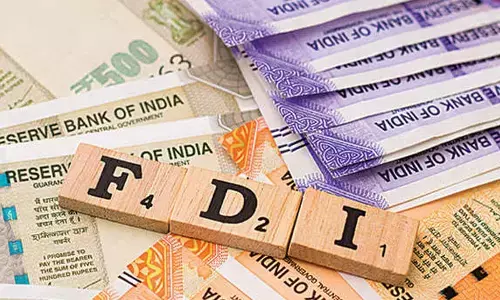Union Budget of India Part- I

The Union Budget of India, also referred to as the Annual financial statement in the Article 112 of the Constitution of India,is the annual budget of the Republic of India. It is presented each year on the last working day of February by the Finance Minister of India in Parliament
The Union Budget of India, also referred to as the Annual financial statement in the Article 112 of the Constitution of India,is the annual budget of the Republic of India. It is presented each year on the last working day of February by the Finance Minister of India in Parliament.
The budget, which is presented by means of the Finance bill and the Appropriation Bill has to be passed by the Houses before it can come into effect on April 1, the start of India's financial year. Every budget consist of actual figures for preceding years, Budget and revised figures for the current year, budget estimates for the following years.
So the budget presented in March 2001 will be estimate of Inflows and outflows of the Funds for the period beginning from 1st April 2001 to 31st March 2002. Timetable for budget is drawn by the Business Advisory Committee (BAC) of Parliament.
In the schedule drawn up by the BAC, there is a fixed period of discussion for each ministry. Budget is to be presented in Lok Sabha on a day as the President directs. By convention, the Budget is presented in Parliament on the last working day of February.
The first Union budget of independent India was presented by R K Shanmukham Chetty on November 26, 1947. Until the year 1999, the Union Budget was announced at 5:00 pm on the last working day of the month of February.
This practice was inherited from the Colonial Era, when the British Parliament would pass the budget in the noon followed by India in the evening of the day. It was Yashwant Sinha, the then Finance Minister of India in the NDA government (led by BJP) of Atal Bihari Vajpayee, who changed the ritual by announcing the 2001 Union Budget at 11 am.
Budget Division in the Finance Ministry has the overall responsibility. It prepares the budget on basis of proposal received from various departments and ministries and the availability of funds. However, final approval is from the Prime Minister.
The Constitution empowers Lok Sabha to grant a Vote-on-Account (Article 116) so that the government can continue with the necessary expenditure into the new fiscal, before the Budget proposals actually get passed after necessary discussions. The vote-on-account normally covers the expenditure requirement of the government for two months.An Interim Budget is not the same as a 'Vote on Account'.
While a 'Vote on Account' deals only with the expenditure side of the government's budget, an Interim Budget is a complete set of accounts, including both expenditure and receipts. An Interim Budget gives the complete financial statement, very similar to a full Budget.
While the law does not debar the Union government from introducing tax changes, normally during an election year, successive governments have avoided making any major changes in income tax laws during an Interim Budget.
Under Article 112 of the Constitution, a Statement of estimated receipts and expenditure of the Union Government has to be laid before the Parliament in respect of every financial year running from 1st April to 31st March. The Receipt and Payments of the Government is categorised in three parts:
Consolidated Fund. : All the inflows like Tax and other Revenues as well as Loans raised by it form part of this category. All outflow including expenses etc also form part of this Account. For withdrawal from this fund parliament authorisation is required.
Contingency Fund: It is the money kept at the disposal of the President to meet out any unforeseen expenses. The corpus of the fund is merely Rs.500 Crores.
Public Account: This category comprises of money raised from various Schemes of the Government like Provident Fund. But this was the technical framework. To put simply it is Annual financial discipline like other corporates prepare Profit and Loss Account and Balance Sheet. However to what disclosure norms the government accounts are subjected to is mystery. We have seldom come across the laid down norms like other balance sheets to disclose the information in a manner prescribed.
Also Read: Nationalisation of banks -I, Nationalisation of banks - Part II, Understanding Monetary Policy Committee.
Procedure of approval of budget:
The Finance Minister introduces the budget in the Lower House of the Parliament or the Lok Sabha & makes a short speech, giving an overall view of the budget. After the presentation of the Budget, Parliament allots some time for a general discussion on the Budget. The finance minister replies at the end of the general discussion.
The reply is also of a general nature and no specifics of the Budget are discussed. However, no motion is moved nor voting required at this stage.After the finance minister’s reply, Lok Sabha takes up for discussion each ministry’s expenditure proposals, and is known as demand for grants. The demands for grants presented by each ministry are taken up by the House.
After, the prescribed period for the discussion on demands for grants is over, the Speaker applies the `guillotine’, and all the outstanding demands for grants, whether discussed or not, are put to vote at once. Only the Lower House is entitled to vote.Appropriation Bill is introduced in the Lok Sabha after it has passed all demands for grants relating to all ministries.
This is to authorise the government to draw funds from the Consolidated Fund of India. Once this Bill is passed, it becomes the Appropriation Act and is certified as a Money Bill.After passing of Appropriation Bill, the Finance Bill is introduced and it incorporates all taxation proposals. At this stage, amendments for tax proposal can be moved. After the passing of this Bill, it enters the statute as the Finance Act. Thus the final Budget gets approved.
The Union Budget 2016 has been crafted under the most extraordinarily challenging economic environments India has seen.The external environment is both uncertain and volatile, the inherited logjam caused by stressed banks and the stressed private sector has yet to be broken, poor monsoons have caused immense rural distress, and demand, a central pillar of growth, has been tepid.
Many of the measures needed to face up to this challenge are not, strictly speaking, budgetary.It has a much greater sense of purpose and direction. It signals macroeconomic credibility by adhering to fiscal deficit targets.
The ambitious provision of LPG connections to all is quite revolutionary, for its health, gender justice and aspirational effects, though its political-economy effects on the subsidy bill will become clear over the next few years.It goes to great lengths to reverse the government’s pro-corporate image
Features of 2016-17 Budget:
Taxation:
The principal tax rates have reached stability. The rates of direct taxes are comparable to international rates (except for personal tax brackets, which vary across countries on account of differing price levels); and indirect taxes are in a long process of replacement by the Goods and Services Tax, which is stuck in disagreements between States.
For 2016-17, the Finance Minister has promised to bring this ratio down to 3.5 per cent primarily through a 20 per cent increase in indirect taxes and as much as 39 per cent in excise duties , even as the corporate taxes go down.
A rise in indirect taxes as opposed to direct taxes is may lead to a case of regressive taxation because both the poor and the rich pay the same tax per unit of purchase of an item.
Indirect Taxes may also lead to Inflation through subsequent increase prices of goods and services.
Taxation of thee provident fund although suggested initially has now been reverted due to strong opposition from the middle class.The salaried class strongly opposed a move to tax 60 per cent of the corpus created from contributions to the Employees’ Provident Fund starting April 1 as part of a move to create a ‘pensioned society’.
Addressing the slowdown
A Budget in difficult times should address the problem of a slowdown squarely. It can do it in two ways:
- Directly by injecting demand into the economy
- Indirectly by creating opportunities for other sources of demand to pick up.
An economy grows based on demand for its goods and services. There are broadly five sources of demand in an economy:
- Consumption by the poor,
- Consumption by the rich,
- Private investment,
- Fiscal deficit and
- Trade surplus.
Contrary to popular belief, the indirect effects of a Budget are positively related to the direct effects of it. So, while a rise in the fiscal deficit directly increases the profits as well as wages in the economy, thereby pushing demand up, it indirectly increases private investment if ‘business sentiments’ are low otherwise.
Fiscal consolidation quick-fixes:
The Finance Minister has maintained that he will adhere to the ‘fiscal consolidation’ map, which means bringing down further the fiscal deficit as a proportion of GDP.
- Fiscal deficit is essentially government expenditure minus its tax revenue. So, bringing it down means a fall in government expenditure and/or a rise in tax revenue as a proportion of GDP.
- Budget for 2016-17 sticks to the commitment made under the Fiscal Responsibility and Budget Management Act 2003 by keeping the fiscal deficit target at 3.5% of GDP.
- This problem becomes doubly difficult if the estimate of the GDP itself is inflated, which is what has happened this year.
- The revised estimate of the GDP for 2015-16 is less than the Budget estimate by about Rs. 5,41,753 crore. If the denominator itself is falling in a ratio, the numerator has to fall further for the ratio to decrease.
- The way they have managed to keep the ratio to 3.9 per cent despite such a fall in the estimated GDP is through increased collection in the indirect taxes and excise duties even as the non-plan expenditure has declined.
- The raise in indirect taxes requires the poor to pay increased indirect taxes while the cushion of the social sector is consistently taken away from them. However unlike between 2012-13 and 2014-15, fiscal consolidation in 2015-16 is not being achieved by paring capital spending but through subsidy reduction afforded by sharply lower crude prices. This has improved the spending mix of the government with a tilt towards infrastructure.
Structural factors aiding the fiscal math :
- Improved coverage and higher tax on services.
- In the current fiscal, service tax collections were marginally higher than budgeted despite slowing growth in the services sector.
By: Balalatha Mallavarapu
(The writer is a senior civil servant)




















